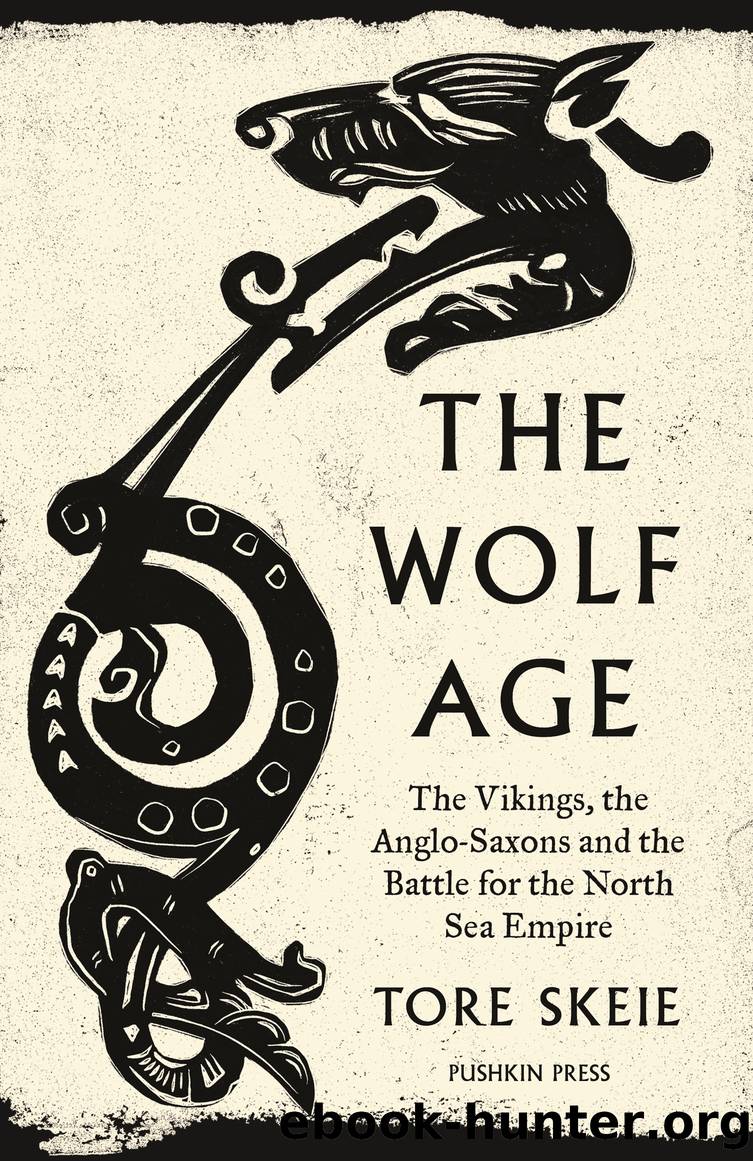The Wolf Age: the Vikings, the Anglo-Saxons and the Battle for the North Sea Empire by Tore Skeie

Author:Tore Skeie
Language: eng
Format: epub
Publisher: Steerforth Press
Published: 2021-12-15T00:00:00+00:00
TO NORWAY
generations before Harald Bluetooth conquered his neighbours and created his Danish super-kingdom, another kingdom was created in the far north of modern Norway. Even long before the Viking Age began, the merciless but resource-rich coasts of HÃ¥logalandâthe area that stretched north from the Trondheim Fjord along mountainous chains of islands and fjords past Lofotenâwere a centre of financial and political power. By the mouths of the great fjord systems that carved their way into the country, Norse chieftains ruled over strategically established power and trading centres, small, densely populated societies that lived by utilizing the nature around them.
From places like Bjarkøy, Bø in VesterÃ¥len and Steigen on Engeløya, the chieftains sent scores of workers and slaves out to collect eggs on the islands in the spring, and on fishing expeditions in the summer. The HÃ¥logaland chieftains sailed north around Gamvik, the mainlandâs northernmost point, into the Barents Sea, and on into the White Sea surrounded by modern Russia, where they exchanged and traded goods with local tribes who were known as âBjarmiansâ. They used âFinnsââthe Sámiâas hunting specialists during the reindeer- and bird-hunting season in the autumn. The Sámi lived not only in the far north, in Finnmórkââthe land of the Finnsââ but also much further south than in later times. Their culture and shamanic religion strongly influenced the Norse peoplesâ own culture and worship. The HÃ¥logaland chieftains on the coast regarded the Sámi as their subjects, and regularly led armed bands of warriors into their territory in order to collect tributes from them.
All this brought in a significant volume of goods that were exotic, luxurious and sought after in Europe, for which the HÃ¥logaland chieftains could earn great sums at the markets further south. Merchantsâand often the chieftains themselvesâsailed their wide trading ships south, loaded with skins, furs, rope, walrus tusks, whalebone, down and feathers and soapstone. Some of these items were sailed into the Trondheim Fjord and transported east via rivers or overland to Härjedalen and Jemtland, and south into Sweden. But most were taken south along the outstretched and broken North Sea coastline, past south-western Norway and all around the coast into Skagerrak, to Vestfold, from where the goods were transported south into the kingdom of the Danish kings. If one came ashore at night and sailed only with a favouring wind, the journey from HÃ¥logaland to the market town of Skiringssal in Vestfold took a month.
This was the ancient sea route the Anglo-Saxons called Norðweg and the Franks Northvegia, that is, the âNorth Wayâ. It was originally a purely geographical name, and did not designate any kingdom or country. But the North Way linked people together. In the still waterways all along the broken coastline lay strategically situated ports, marketplaces and the seats of chieftains; small but important places with wharfs and loading docks and rows of workshops and diminutive buildings. The trade and connections it created bound together local societies from north to south: people from HÃ¥logaland, Trøndelag, Møre, Sogn, Hordaland and Rogaland, descendants
Download
This site does not store any files on its server. We only index and link to content provided by other sites. Please contact the content providers to delete copyright contents if any and email us, we'll remove relevant links or contents immediately.
Room 212 by Kate Stewart(5040)
The Crown by Robert Lacey(4731)
Endurance: Shackleton's Incredible Voyage by Alfred Lansing(4683)
The Iron Duke by The Iron Duke(4293)
The Rape of Nanking by Iris Chang(4139)
Joan of Arc by Mary Gordon(4016)
Killing England by Bill O'Reilly(3953)
Say Nothing by Patrick Radden Keefe(3903)
I'll Give You the Sun by Jandy Nelson(3359)
Shadow of Night by Deborah Harkness(3307)
Hitler's Monsters by Eric Kurlander(3269)
Mary, Queen of Scots, and the Murder of Lord Darnley by Alison Weir(3152)
Blood and Sand by Alex Von Tunzelmann(3140)
Darkest Hour by Anthony McCarten(3072)
Eleanor & Park by Rainbow Rowell(3063)
Margaret Thatcher: The Autobiography by Thatcher Margaret(3029)
Red Famine: Stalin's War on Ukraine by Anne Applebaum(2874)
Book of Life by Deborah Harkness(2869)
The One Memory of Flora Banks by Emily Barr(2803)
